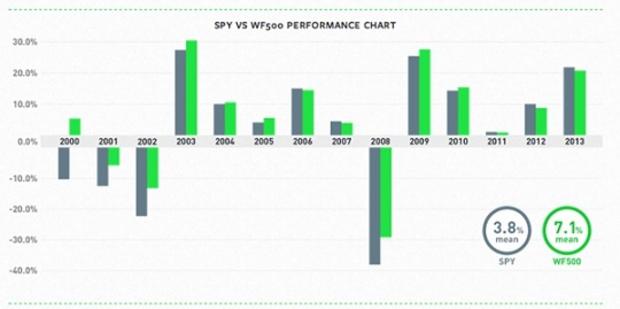A tax-friendly strategy that's better than indexing?
I’ve heard many claims of investment strategies that are better than indexing. But Wealthfront, an online investment company with over $500 million under management, may have just come up with one that actually might have some validity. They call it the tax-optimized US index portfolio, or Wealthfront 500. Here's how it works and my evaluation of its features.
Taxes matter in investing, and for some time, Wealthfront has located assets where they are most efficient and has done "tax-loss harvesting" when warranted. Tax-loss harvesting is selling a security after a loss and replacing it with a similar security. These tax losses can be used to either offset gains or be carried forward into future years to offset gains, in addition to the $3,000 in net losses one can take annually.
For example, let's say you were in a Vanguard Total Stock Index ETF (VTI) that lost 20 percent of its value. Wealthfront could sell this fund and buy the Schwab Broad Market Index ETF (SCHB) without waiting the 31 days needed to avoid the IRS wash rule that would void the loss for tax purposes. This type of tax-loss harvesting is something I’ve recommended for years.
The Wealthfront 500 takes tax-loss harvesting from the asset-class level of
ETFs to the specific-stock level.
Wealthfront Chief Operating Officer Adam Nash explained that for accounts over $500,000, the client will have the option of replacing the Total Stock Index with a combination of the Wealthfront 500 strategy and the extended market index fund. The extended market index comprises virtually every US-based stock that isn’t in the S&P 500. It's known as a completion index because owning the right proportion of both builds a total US stock index fund.
Rather than buy an ETF
following the S&P 500, Wealthfront buys virtually all 500 companies, in proportion to their total value (market capitalization). For example, even though the S&P 500
rose by 29.6 percent (plus dividends) last year, all stocks didn’t, such as IBM (IBM), which declined. Wealthfront could have sold IBM during
the year and used the proceeds to buy more of a company that should perform
very similar to IBM.
Thus, Wealthfront’s goal is to track the index. Then, 31 days later and depending on several variables, Wealthfront could buy IBM again.
According to Wealthfront, this strategy can add approximately 1.6 percent in annual return to your portfolio in tax savings. In fact, back-testing their software shows the returns were 3.3 percentage points higher for this portion of your portfolio, though each year can vary greatly. To be sure, Wealthfront isn’t the first to use this strategy but because the process is all software-based, it's the first I know of to do this for a 0.25 percent annual charge.
I read the Wealthfront whitepaper and asked Nash some tough technical tax questions on its calculations, down to a level of detail that would confuse many CPAs. Based on his answers, I was satisfied the calculations were right, but with several caveats.
First, the tax bracket used was for someone living in California (where the firm is based) making over $1 million annually. Next, Wealthfront made the assumption that the tax loss could be used immediately and didn’t need to be carried forward into future years. Finally, it made the assumption that taxes would not have to be paid on the unrealized gains from the portfolio.
My take
While the calculations may be correct, I think the assumptions generally overstate the value of the tax savings. Most people don’t have a $1 million income and live in California. Most will eventually sell the stocks and use the money for retirement, buying a house, sending a child to college, etc. Daniel Knight, an independent CFA in Denver says, “it’s an intriguing idea, but possible future increases in the capital gains tax rates could negate the benefits of the tax loss harvesting.”
That said, though the value may be overstated, tax-loss harvesting at the individual-stock level should increase overall wealth. Doing this for a fee of only 0.25 percent annually is a great innovation. Risks include the fact that returns could vary greatly from the S&P 500 itself, also known as tracking error.
This innovation, however, isn't available as a stand-alone product. At least for now, it must be part of an overall allocation. Though I’d love to see it as a stand-alone product, firms like Wealthfront do a great service to investors in developing low-cost, tax-efficient portfolios for only 0.25 percent annually. They aren’t perfect, however, as their risk profile survey told me I should have 91 percent of my portfolio in equities and commodities. I'm sticking with my 44 percent equity allocation. Nash explained that discussing with an adviser would have likely led me to a more conservative allocation closer 45 percent equities.
